The state flag for all 50 states: See the state flags (plus D.C.) and the meaning behind each.
While most Americans are familiar with the stars and stripes of the U.S. flag, others may not know the details and symbols of the other 51 flags of the nation.
Each state's flag is representative of its history and distinct symbols.Here are the 50 official state flags from Alabama to Wyoming, as well as Washington D.C., and their significances.
50 U.S. state flags, plus the District of Columbia
Alabama
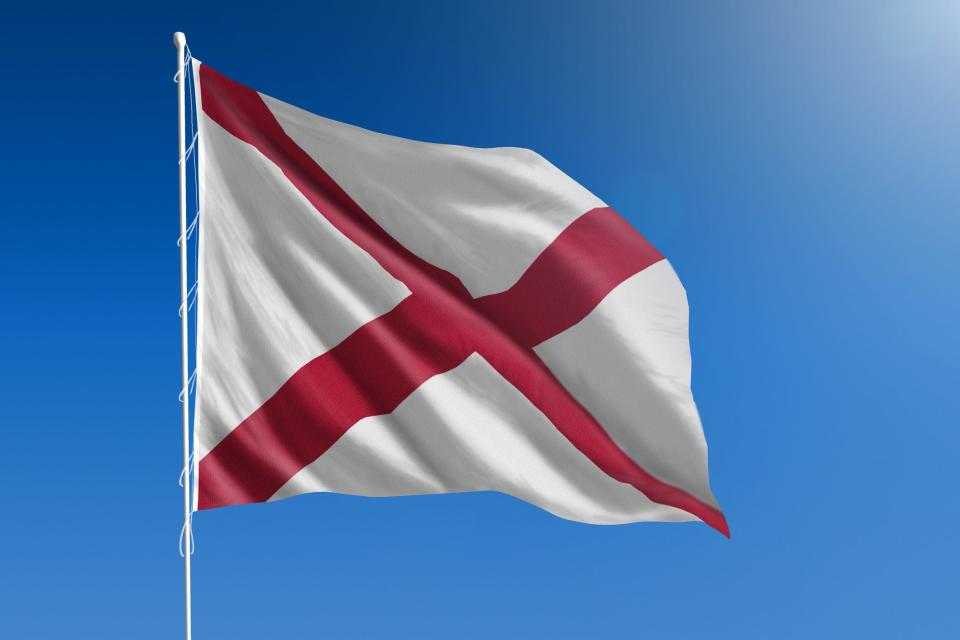
The Alabama state flag is white with a red cross of St. Andrew. This design was adopted in 1895. The flag's design was inspired by the Confederate battle flag.
Alaska
Alaska's state flag features eight gold stars, which form the Big Dipper and Polaris, against a dark blue backdrop.
The Polaris, or North Star, on the flag is a symbol of Alaska’s northern location. The Big Dipper is a symbol of strength, while the blue background represents the night sky.
Arizona
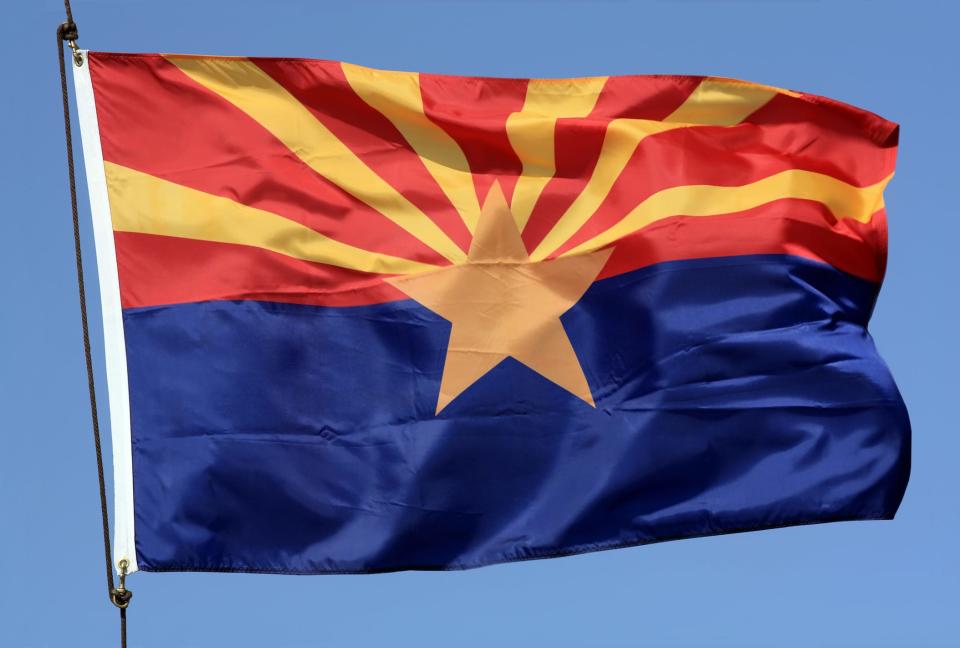
The gold star on this state flag represents one of Arizona's five C's: copper. Arizona produces more copper than any other state in the nation. The 13 alternating gold and red stripes symbolize the sun.
Blue and gold, which is featured on the flag, is also Arizona's state colors.
Arkansas
Arkansas was the first state in the U.S. to produce diamonds, hence the large diamond in the center of its state flag. The 25 white stars represent Arkansas being the 25th state to join the Union.
The three blue stars under the state’s name symbolize represent the three nations Arkansas was part of before officially becoming a state: Spain, France and the U.S. The star above the word “Arkansas” represents the state’s membership in the Confederacy.
California
The California state flag adorns the state's official animal, the grizzly bear, which represents strength. The grizzly bear imagery was inspired by a 19th century painting by California artist Charles Nahl.
Colorado
The colors of Colorado's state flag represent the environmental features of the state. The white symbolizes the snowy mountains, gold for sunshine, red for the state's soil and blue for the sky.
The "C" stands the state's name, the columbine (the state's flower) and centennial. Colorado became a state in 1876 — the 100 year anniversary of American independence.
Connecticut
The three grapevines on the Connecticut state flag are believed to represent the three settlements (Windsor, Wethersfield, and Hartford) or three colonies (Connecticut, Saybrook and New Haven) which merged together to form the state.
The state motto, “Qui transtulit sustinet,” is displayed in a white ribbon. It translates to “he who transplanted still sustains."
Delaware
"December 7, 1787" displayed at the bottom of Delaware's state flag is the date Delaware became the first state of of the Union.
The coat of arms contains several state symbols. The ship represents the shipbuilding industry and coastal trade. The militiaman symbolize the citizen-soldier who help maintain American liberties. The water represents the Delaware River.
District of Columbia
The flag of Washington D.C. is based on the Washington family's coat of arms, which has three red stars and two red stripes against a white background.
Florida
The seal represents the state’s environmental features, such as sunshine, palmetto trees, lakes and rivers. There is some controversy over the St. Andrew’s cross on Florida’s state flag.
In the late 1890s, Gov. Francis P. Fleming said a red cross be added to reduce the older flag’s appearance, which was simply white with the seal, to a flag of surrender. However, some believe its addition was based on the saltire in the Confederate battle flag.
Georgia
The 13 white stars surrounding Georgia’s coat of arms represent the state and the other 12 colonies which originally formed the U.S.
The flag is reminiscent of the Confederate Stars and Bars with three broad red-white-red stripes and a blue a rectangular area.
Hawaii
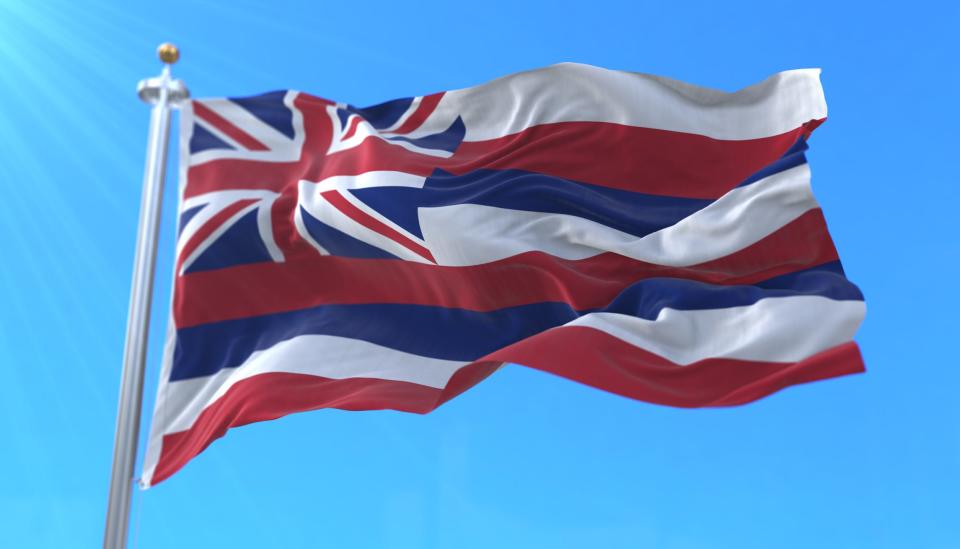
The eight horizontal stripes on Hawaii's state flag represent the eight major islands that make up the state. The corner of the flag includes the Union Jack of the United Kingdom since the islands were once under Britain’s control.
It is the only U.S. state flag to include a foreign country's national flag
Do you know your state's official nickname? Here's the story behind all 50 state nicknames.
Idaho
Idaho's seal in the flag's center represents the state's main industries: mining, agriculture and forestry. It is also features the Idaho's geographic features, including mountains and lakes.
Illinois
The Illinois flag includes parts of the state seal, such as a rock on a stretch of land with water and a rising sun behind it. The seal also includes a shield with the national stars and stripes in the claws of a bald eagle.
The red ribbon has the state motto: “State sovereignty — national union.” The years 1818 and 1868 represent when Illinois became a state and for the first use of the state seal, respectively.
Indiana
The torch on Indiana’s state flag symbolizes liberty and enlightenment. The 13 stars in the outer circle represent the 13 original colonies.
The five stars of the inner semi-circle are for the following five states that joined the Union. The large star above the torch is the 19th on the flag and is representative of Indiana being the 19th state.
Iowa
Each stripe color of the Iowa state flag has meaning. The blue stripe stands for loyalty, justice and truth. The white stands for purity, while the red is for courage.
In the center, an eagle carries blue streamers with the state’s motto: “Our liberties we prize, and our rights we will maintain.”
Kansas
The sunflower is for Kansas' state flower. The gold and blue bars underneath represent the Louisiana Purchase, of which Kansas was part. The 34 stars in the seal represent Kansas being the 34th state to join the U.S.
The seal tells the history of the state through imagery including agriculture and American expansion.
Kentucky
The frontiersman and statesman in the seal represent the people of Kentucky: country and city inhabitants of 1792, when the state was joined the Union.
The state’s motto is also displayed: “United we stand, divided we fall.”
Louisiana
The Louisiana flag features a pelican nurturing its young by tearing at its own breast, symbolizing sacrifice which is signified by three drops of blood. The ribbon underneath has the state motto: “Union, Justice and Confidence.”
Maine
Maine’s flag features symbols of the state's nature, including a pine tree. The white pine is Maine’s state tree, and “The Pine Tree State” is Maine’s nickname.
The moose is Maine's state animal. The farmer represents the state’s agricultural roots, while the sailor is for the state's ties to the sea.
Maryland
The Maryland flag has the coat of arms of the Calvert and Crossland families. The gold and black coat of arms is for Lord Baltimore of the Calverts, who founded Maryland.
During the Civil War, the Calvert coat of arms represented the people of Maryland who wanted to remain in the Union. The red and white are the Crossland colors and represented those who sympathized with the Confederacy.
Massachusetts
The Massachusetts flag has the state’s coat of arms, including an Indigenous man holding a bow and arrow.
The arrow is pointed down, which symbolizes peace. The white star stands for Massachusetts being one of the original colonies. The ribbon has the state motto, which translates to “By the sword we seek peace, but peace only under liberty.”
Michigan
The moose and elk represent Michigan, while the bald eagle symbolizes the United States.
The Latin phrase “E Pluribus Unum” means “From Many, One,” for the U.S. being one nation made of many states. “Tuebor” means “I Will Defend," which refers to the frontier position of Michigan.
The flag also contains the state motto which translates to “If you seek a pleasant peninsula, look about you.”
Minnesota
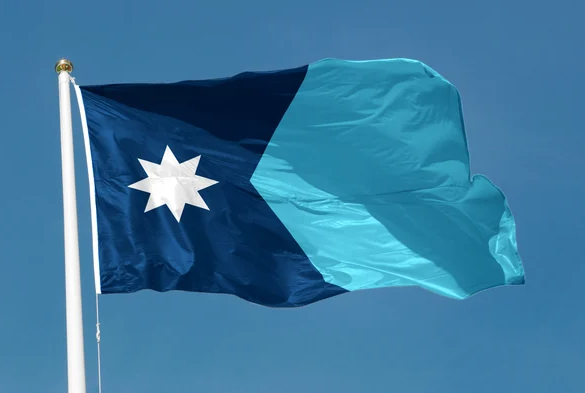
On Dec. 19, a new state flag for Minnesota was approved. The new design was chosen from over 2,600 submissions from the public.
Minnesota's new flag features an eight-pointed North Star, in reference to to the state's nickname — The North Star State. The star is set against a dark blue background with its shape is similar to Minnesota.
The flag will start being used on May 11, 2024, which is Minnesota Statehood Day.
Mississippi
The current Mississippi flag was adopted in 2021, after Mississippi residents voted to replace the 126-year-old Confederate-themed state flag, which featured the Confederate battle symbol.
The flag features a white magnolia blossom, which is the Mississippi's state flower. The 20 stars, represent Mississippi’s admission to the Union as the 20th state.
Missouri
The colors of Missouri's flag have different meanings. The red stripe is for valor, the white stripe for purity and the blue stripe for justice, vigilance and permanency.
The center features Missouri’s state seal encircled by 24 stars, representing Missouri being the 24th state to join the Union.
The two grizzly bears symbolizes the state and its residents' courage and strength. The state motto is featured, translating to “Let the welfare of the people be the supreme law.” The helmet represents the power of the people of Missouri.
Montana
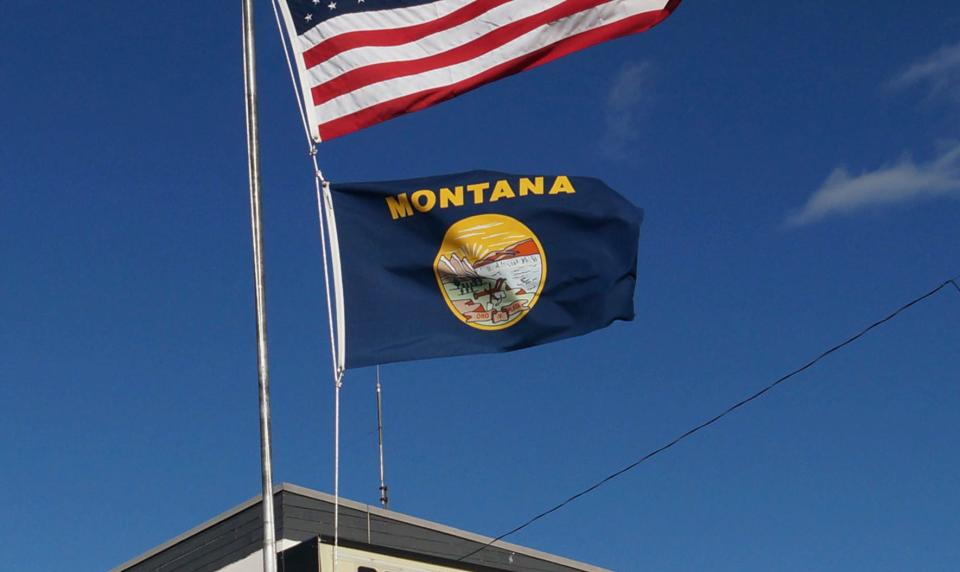
The state seal on Montana's flag features symbols of Montana’s history and environment. The pick, shovel and plow, represent the state’s mining and farming history. A ribbon displays the state motto in Spanish, which translates to “gold and silver."
Nebraska
Nebraska's state flag has its seal against a blue background. The seal features imagery that represents agriculture. The train cars on the flag are meant to head toward the Rocky Mountains. The state motto, “Equality Before the Law," is featured.
Nevada
The Nevada flag features a silver star to symbolize the state's metal: silver. The star is between branches of sagebrush, the state’s flower. The phrase “Battle Born” refers to Nevada joining the Union during the Civil War.
New Hampshire
New Hampshire’s state flag features the state seal with the frigate Raleigh surrounded by laurel leaves. The nine stars symbolize New Hampshire being the ninth state to join the Union.
New Jersey
The colors of the New Jersey state flag, buff and Jersey blue, represent those chosen by George Washington during the Revolutionary War for the state's military.
The state's seal is featured in the center. Its symbols represent agriculture and sovereignty. The horse head is for New Jersey’s official state animal.
The women on the flag are Liberty and Ceres, the Roman goddess of grain and a symbol of fruitfulness.
New Mexico
The New Mexico state flag has a modern interpretation of the ancient Zia sun. Four is the sacred number of the Zia, representing the four points of the compass, the four seasons of the year, the four periods of each day and the four stages of life.
The colors on the state flag are the red and yellow, similar to the Spanish flag as New Mexico was part of Spanish Empire until the 19th century.
Just Curious: We're here to help with life's everyday questions
New York
The New York state flag features its coat of arms. Lady Liberty and Justice support the shield, and Liberty’s left foot stands on a crown to represent freedom from Great Britain. Justice is blindfolded to symbolize impartiality and fairness. The state motto is displayed Latin, which means “ever upward.”
North Carolina
The date May 20, 1775 refers to the Mecklenburg Declaration of Independence. The second date April 12, 1776 commemorates the Halifax Resolves, which was one of the first official calls for independence from Great Britain during the American Revolution.
North Dakota
The olive branch on North Dakota’s state flag symbolizes peace. A ribbon features the state motto in Latin, which translates to “out of many, one,” in reference to the U.S.
A shield with 13 stripes represents the original colonies. The state flag conforms to the color, design and size of the regimental flag used by North Dakota Infantry in the Spanish-American War in 1898.
Ohio
The Ohio state flag is the only non-rectangular U.S. state flag. Its unique swallowtail design was by John Eisemann.
The blue triangle represents the state’s hills and valleys. The red and white stripes symbolize the roads and waterways of the state. The 13 white stars around the circle represent the original colonies and four at the apex of the triangle bring the total to 17, representing Ohio as the 17th state to join the Union.
Oklahoma
The blue background of Oklahoma’s state flag symbolizes devotion and loyalty. The traditional Osage buffalo-skin shield represents defensive or protective warfare.
The olive branch, stands for the settlers, and the peace pipe, for Indigenous people, appear on top of the shield.
Oregon
Oregon's flag is the only state flag to have different designs on each side. Navy and gold are Oregon’s state colors. The front of the flag features the state seal. The year 1859 represents when Oregon was admitted to the Union. The 33 stars signify Oregon being the 33rd state to join the Union.
The back of the flag has a beaver, the official state animal.
Pennsylvania
Pennsylvania’s flag features its coat of arms, which represents commerce and agriculture. The two horses symbolize strength. The state motto “Liberty, Virtue, Independence” is on a red ribbon at the bottom.
Rhode Island
The 13 stars on Rhode Island’s flag represent the 13 original colonies and Rhode Island being the 13th state to enter the Union. A gold anchor and blue ribbon with the state motto, “Hope," are featured in the center.
South Carolina
South Carolina's state flag is based on the blue uniforms and white crescent badges crescent worn by its troops during the Revolutionary War. The flag also features the state tree: the palmetto.
Did you know most states have an official dinosaur or fossil? It's true! Here's yours.
South Dakota
South Dakota’s flag features its state seal, which symbolizes the state’s commerce, agriculture, industry and natural resources. The state motto, “Under God the People Rule,” appears on a ribbon.
The year 1889 stands for when South Dakota officially became a state.
Tennessee
The stars on Tennessee’s flag represent the state’s "grand divisions": East, Middle and West Tennessee. They are placed in a circle to symbolize unity.
Texas
The Texas flag is the same as the 1839 Republic of Texas flag, from when the state was an independent nation. The single white star gave rise to Texas’ nickname, “The Lone Star State.”
The red, white and blue of the state flag represent bravery, purity and loyalty, respectively.
Utah
The historic Utah state flag featured a bald eagle, the state motto and two dates: 1847 when Mormon pioneers first came to Utah and 1896: When Utah became the 45th state.
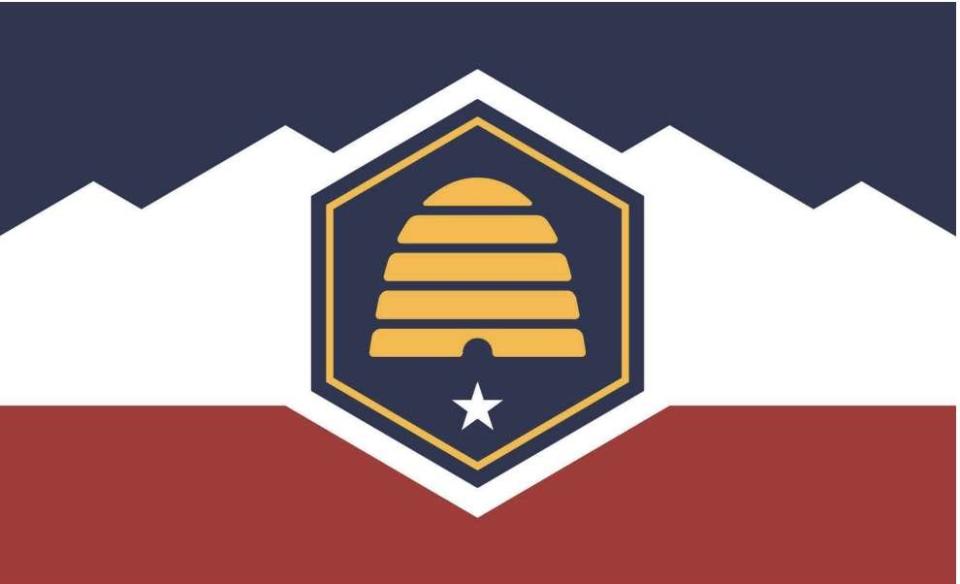
The state's new flag will be adopted as of March 9, 2024, after Utah legislature approved its bill for the governor's signature. The beehive flag is blue for the state's lakes and skies, red for the state's red rocks and white for its snowy mountain peaks.
The beehive stands for Utah's history and community. The hexagon surrounding it represents strength and unity. The white star symbolizes hope and 1896, the year of Utah's statehood.
Vermont
The coat of arms on Vermont’s flag represents the state's agriculture. The two pine needle branches symbolize those worn by the soldiers of Vermont during the Battle of Plattsburgh during the War of 1812.
The deer head signifies the state’s wildlife. The state motto "Freedom and Unity" is also featured.
Virginia
The Virginia flag features its official state seal. The seal depicts the goddess Virtus, who represents Virginia. She is standing over a defeated tyrant.
The state's motto is shown in Latin, which means “Thus always to tyrants.”
Washington
Washington’s flag is the only state flag to display an actual person: George Washington. Additionally, Washington is the only state with a flag that has a green background.
West Virginia
The West Virginia flag has its state motto in Latin, which translates to “Mountaineers are always free.” There is a wreath of rhododendron, which is the state flower, featured. June 20, 1863 represents when West Virginia became a state.
Wisconsin
The Wisconsin flag features the state's seal. The sailor and miner symbolizes the workers in the state. The tools signify the important trades: agriculture, mining, manufacturing and navigation. The badger, Wisconsin's state animal, is also shown.
The year 1848 refers to when Wisconsin was joined the Union. The state’s motto “Forward” is displayed.
Wyoming
On Wyoming's flag is a bison, which is the state's official animal. The red border symbolizes the Indigenous people who first lived in the region. It also symbolizes the blood of those there.
This article originally appeared on USA TODAY: US state flags: Every state flag (plus D.C.) and meaning behind each

 Yahoo Movies
Yahoo Movies 
